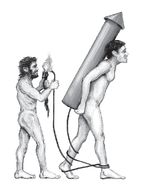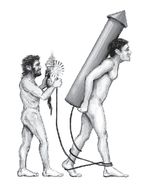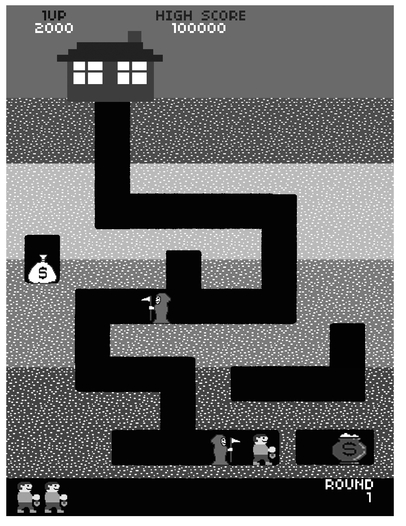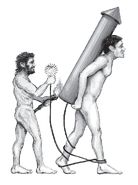The Darwin Awards Countdown to Extinction (27 page)
Read The Darwin Awards Countdown to Extinction Online
Authors: Wendy Northcutt
Quorum sensing works like this: An individual bacterium constantly releases a particular chemical into its environment, telling its brethren, “I’m here!” Other bacteria of the same species hear this message while releasing their own “I’m here!” chemical. The bacteria sense the concentration of that chemical and are thus able to estimate how many of their siblings are in the immediate surroundings. Armed with this information, they make decisions based on their quantity.
For humans, bacterial quorum sensing can be deadly.
For example, a lone member of a life-threatening species might get into your body. By itself, it stands no chance of evading your immune system and taking you down. Producing toxins, or doing anything except laying low in such an environment, would be a waste of energy.
But there is strength in numbers. Over time, the bacterium multiplies, and perhaps a few more sneak into your body, each loudly announcing its presence while multiplying furiously. Soon enough, there is a whole bacterial chorus shouting to the world of their arrival. Once the bacteria have massed enough troops to take you down, they begin their attack and pump out toxins. You get sick. Without treatment, you may die.
While the scenario seems dire, understanding quorum sensing is giving researchers hope. Biologists are learning how to decode this bacterial language and produce chemical tools that “jam” some of the communication lines.
This method is a brand-new tactic in the fight against antibiotic resistance.
Quorum sensing evolved billions of years ago, so it is likely to be much harder for bacteria to develop immunity to these weapons, compared to the relative ease of defeating traditional antibiotics.
This method is a brand-new tactic in the fight against antibiotic resistance.
Quorum sensing evolved billions of years ago, so it is likely to be much harder for bacteria to develop immunity to these weapons, compared to the relative ease of defeating traditional antibiotics.
Scientists are now manufacturing molecules that silence the bacterial dialogue, turning the bacteria’s advantage into a disadvantage.
Antibiotic-resistant bacteria are a serious problem worldwide. Our reliance on penicillin, ampicillin, and other antibiotics—while lifesaving—has produced some nasty strains of killers. For instance, one of the most well-studied quorum-sensing bacteria is the opportunistic
Pseudomonas aeruginosa
. Some strains are highly resistant to antibiotics, and this microbe is often responsible for nosocomial infections—pneumonia and wound infections acquired during a patient’s stay in a hospital.
Pseudomonas aeruginosa
. Some strains are highly resistant to antibiotics, and this microbe is often responsible for nosocomial infections—pneumonia and wound infections acquired during a patient’s stay in a hospital.
P. aeruginosa
colonies are clever. They signal to one another when a host’s white blood cells are on the march and, as a group, produce a chemical that eliminates the white blood cells, disabling a patient’s immune system. And once these shrewd bugs know that they’ve reached high density in a body they can enter into a state known as a biofilm, a gooey layer of germs and proteins that acts as a shield against antibiotics.
colonies are clever. They signal to one another when a host’s white blood cells are on the march and, as a group, produce a chemical that eliminates the white blood cells, disabling a patient’s immune system. And once these shrewd bugs know that they’ve reached high density in a body they can enter into a state known as a biofilm, a gooey layer of germs and proteins that acts as a shield against antibiotics.
But, by knowing which chemicals are used to coordinate this conspiracy, doctors may someday gain the upper hand and turn the
P. aeruginosa
deaf to their comrades. Without speech, individual bacteria will no longer be able to go about their trickery. This could be a huge boon to hospital patients, particularly immune-compromised ones such as those with AIDS or undergoing radiation therapy.
P. aeruginosa
deaf to their comrades. Without speech, individual bacteria will no longer be able to go about their trickery. This could be a huge boon to hospital patients, particularly immune-compromised ones such as those with AIDS or undergoing radiation therapy.
Aside from medical applications, there are many interesting complexities to quorum sensing.
A microbe never lives alone: A diverse jungle of species usually surrounds it. While each has its own language, there is a second system—a bacterial
lingua franca
—that allows all species to communicate with one another. Referred to as quorum-sensing cross talk, this scheme allows bacteria to measure the total amount of other species in their neighborhood. Researchers are just beginning to understand this cross talk, which could allow species to make decisions together based on the local environment.
lingua franca
—that allows all species to communicate with one another. Referred to as quorum-sensing cross talk, this scheme allows bacteria to measure the total amount of other species in their neighborhood. Researchers are just beginning to understand this cross talk, which could allow species to make decisions together based on the local environment.
Furthermore, using genetic analysis, researchers discovered that bacteria have been “speaking” for far longer than we have. Quorum sensing is so widespread in bacteria that it must have evolved billions of years ago and provided such a survival advantage that it stuck around. By studying the genetic changes that control quorum sensing, scientists will be able to trace lineages and better understand bacterial evolution.
In fact, since quorum sensing has been around for so long, it means that we multicellular creatures came into being against a chattering background. Some scientists believe that learning about bacterial communication will give insight into how our own cells organize into tissues and organs, a process that obviously involves close coordination.
As humans, we sometimes think of ourselves as standing on the top rung of the evolutionary ladder. But all organisms have an equally long history. Humans aren’t so exalted, evolutionarily speaking, and lowly bacteria routinely humble us with their highly attuned chemical signaling.
Bacteria were here first, and they set the rules. Perhaps if we learn to speak their language, we will alter the rules enough to help ourselves. But we should never forget that the ones in charge are the smallest. The meek shall inherit the earth; in fact, they already have.
For more information, visit the University of Nottingham’s quorum-sensing site:

CHAPTER 3
TOOLS: THE MONKEY WRENCH
“When you tempt fate . . .” Man is called the tool-using animal. So what do we call a man who misuses tools? Well, much of the time we call him a Darwin Award Winner. The human animal is remarkably creative in finding ways to mishandle everything from a basic shovel to more sophisticated tools like chainsaws, drills, air compressors, washing machines, and Tasers. Wait! Don’t touch that knob . . .
Fool’s Gold • Rub the Mint • Saw It Coming! • A Drilliant Idea • It’s the Cure That’ll Kill You • Spin Cycle • A Putty Bullet


Confirmed by Darwin
Featuring money and a shovel
5 FEBRUARY 2009, INDIA | Bachelor lottery agent Pravin K. lived with his brother’s family in Vasai. His own house, an abandoned hundred-year-old building, was located a few meters away.
Some legends hold that a pot of gold lies buried at the end of the rainbow, but Pravin learned in a dream that an ancient pot of gold was actually buried beneath his house! He decided to “follow his dreams” and dig for that gold. He kept his plans private to avoid a fight over the fortune.
The dream told him to dig beneath the staircase, so after lunch every day without fail, Pravin would take his spade and dig a little deeper beneath the stairs. The neighbors had no idea that days and nights of digging had resulted in a long, fifteen-foot-deep tunnel. The innovative gold digger had even rigged a remote-control toy car to carry a flashlight to assist him in the dark!
He was smart enough to control his lighting needs, but not smart enough to take into account the water table. One day the thirty-two-year-old lottery agent did not return home, and his worried relatives lodged a missing persons report. Police discovered that the floor of the old house had caved in. The soil beneath the staircase becomes wet at a depth of five meters due to its proximity to the sea, and the unsupported walls of the tunnel had collapsed.

A few hours later an earthmover excavated Pravin’s body from the debris, along with a spade and the innovative mobile flashlight. The lottery agent’s number . . . was up.
Reference:
Mumbai Mirror
Mumbai Mirror
BEACH GETAWAY
Digging a hole sounds simple enough but it’s actually a dangerous activity.
Sunny, sandy beaches can get crowded, even on a winter day. In December 1997, a quest for privacy and protection from the wind prompted D. Jones to dig an eight-foot-deep hole on the beach in Buxton, North Carolina. He unfolded a beach chair at the bottom of the pit, and was enjoying his hard-won seclusion when the wet sand collapsed, burying him in a suffocating slide. Although digging for privacy—or for gold—may seem to be a harmless pastime, distinct danger lurks in the depths of a deeply dug hole.
Reference:
Darwin Awards 4: Intelligent Design
Darwin Awards 4: Intelligent Design
(Plume, 2007)
Unconfirmed Personal Account
Featuring school, work, and an air compressor!
DECEMBER 1988, ROMANIA | I was a student of electricity and mechanics in Communist Romania. At the time, it was mandatory for all children, including university students, to boost the economy by “active participation.” Each autumn we worked in agriculture, harvesting fruits and vegetables, and for three weeks per year we were required to train in a power plant or factory, to get a feel for successful Communist industry. This was known as “Rub the Mint.”
My class was sent to Slatina where aluminum was obtained with the power-hungry electrolysis process. We were not much use, so we were ignored by the people in charge of our training. We spent our copious down time reviewing our class notes. Not only were the students bored, but so were many workers in the factory, who were actually paid for doing nothing.
One day I was assigned to walk documents from one department to another. Along the way, I spotted two men crafting a wooden coffin. I was accustomed to all kinds of crazy sights, but a coffin . . . ? Was the aluminum factory branching out into funeral supplies?
“The coffin is for a comrade who accidentally removed himself from the gene pool,” the woodcrafters told me. And how had this accident come to pass?
Two men in their twenties, recent hires, were fiddling with the pressurized air hose used to power industrial air tools. They swept the dust off their dusty clothes, and this was so much fun that one of them dropped his pants to feel the air sweep across his testicles. He bent over further, and bet his comrade that he had the guts to pressurize his guts, and maybe experience some fun farts. He proceeded to stick the hose in his anus and release six bar (atmospheres) of pressure, inflating and rupturing his intestines.
Other books
What the Dead Want by Norah Olson
Full Impact by Suzanne Weyn
Bikers Don't Ask Twice:: (Outlaw MC Erotica) by Roseleigh Gorge
Maohden Vol. 1 by Hideyuki Kikuchi
The Lubetkin Legacy by Marina Lewycka
Love Lies Dreaming by C. S. Forester
Uncommon Enemy by Alan Judd
Best Friends by Thomas Berger
The White Zone by Carolyn Marsden
The Raven Mocker by Aiden James